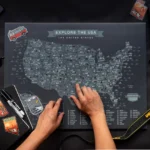Introduction: The Office on Your Back
In the world of perpetual travel and remote work, there is one item that stands between you and pure, unfettered freedom: your backpack. Forget the romantic images of beachside remote work and sunset train rides; if your gear fails or your back gives out, the lifestyle grinds to a halt.
Most people try to make do with an old hiking pack or a bulky roller suitcase, but these fail quickly. A true digital nomad requires a specialized tool, the nomadic backpack. This single piece of gear must serve simultaneously as your office, your closet, your filing cabinet, and your lifeline. It is the only physical container that holds your entire professional and personal life.
The right nomadic backpack is transformative. It maximizes comfort, streamlines organization, ensures carry-on compliance (saving you hundreds in baggage fees), and ultimately liberates you from physical strain and logistical headaches. Let’s break down the essential features that make a bag the backbone of your mobile lifestyle. If you’re ready to dive deeper into the logistics and spirit of this movement, read our guide on Embracing the Open Road and the Nomadic Lifestyle.
The Five Non-Negotiable Pillars of the Nomadic Backpack
A bag doesn’t become a nomadic backpack just by being large; it becomes one through intelligent design engineered for constant movement and rapid repacking across continents. When shopping, prioritize these five features above all else.
Size and Carry-On Compliance (The 40L-45L Sweet Spot)
The golden rule of nomadic travel is: Never check a bag. Losing your luggage means losing your passport, laptop, and means of income. Therefore, your bag must consistently fit within the strict carry-on limits (typically around 55 x 35 x 20 cm or 22 x 14 x 9 inches).
- The Ideal Range: Bags between 40 liters and 45 liters hit the sweet spot. They provide enough volume for 7-10 days’ worth of clothing and essential gear, yet they compress just enough to fit into most airline overhead bins and comply with budget carrier rules without issue.
Clamshell Opening
Traditional hiking packs are top-loading tunnels, meaning you must pull everything out to reach the socks at the bottom. This is inefficient and messy. A true nomadic backpack features a clamshell opening that zips open entirely, like a suitcase. This allows you to:
- View all your contents instantly, even when packed in cubes.
- Pack and unpack efficiently in small hostel rooms or train cabins.
- Keep clothing flat and organized.
Dedicated Tech Organization
Your work tools, laptop, tablet, chargers, and drives are non-negotiable. The ideal pack includes a separate, padded sleeve for your computer (must fit 15″ or larger) that is accessible from the exterior. This is vital for airport security checks, allowing you to quickly pull out and replace your device without ever having to open your main clothing compartment. Look for sleeves that are suspended off the bottom of the bag to prevent damage when setting the nomadic backpack down hard.
Comfort and Weight Distribution
A digital nomad might carry their entire life on their back for miles, navigating airports and city streets. Comfort is paramount for long-term spinal health. Look for professional suspension systems, including:
- Padded Hip Belt: This is mandatory. It transfers up to 80% of the bag’s weight from your shoulders (which tire quickly) to your hips (which are designed to bear weight).
- Sternum Strap: Keeps the shoulder straps in place and helps distribute tension across the chest.
- Load Lifters: Small straps near the top of the shoulder straps that pull the weight closer to your back, improving balance and posture.
Durability and Water Resistance
Your bag will be dragged across cobblestone streets, stuffed under bus seats, and exposed to unpredictable weather. Look for high-denier nylon or polyester fabrics (500D or higher) and YKK zippers, which are the industry standard for reliable hardware. Basic water resistance is essential for protecting expensive electronics from unexpected rain showers. Don’t compromise quality here; a broken zipper can ruin a travel day.
Advanced Organization: Packing Like a Professional Nomad
A great nomadic backpack provides the framework, but the professional traveler must supply the system. The best designs are built to eliminate the need for “digging.”
Quick-Access Pockets
Look for secure, yet instantly available, small pockets near the top or on the exterior side panel for critical items like your passport, wallet, and phone. These should be easy for you to reach but difficult for a pickpocket. Organizing your documents this way reduces pre-flight anxiety and streamlines border crossings.
Using Packing Cubes
The true secret weapon of the organized traveler is the packing cube. These zippered fabric containers compress your clothes, keep items categorized, and prevent items from shifting inside the nomadic backpack. By dedicating a cube to shirts, one to pants, and one to electronics, you can lift out exactly what you need without disturbing the rest of the contents. They are a game-changer for maximizing space.
Beyond the Bag: Integrating Your Backpack into Nomadic Life
Choosing the bag is only the first step; learning to live with it is the second.
Weight Management
Always aim to keep your total packed weight under 10 kilograms (22 lbs). This ensures comfort during long travel days, guarantees compliance with most budget airline weight restrictions, and makes maneuvering through crowded public transport manageable. If you find yourself physically struggling to lift your nomadic backpack onto a bus rack, it’s too heavy.
Security Features
Look for thoughtful security additions like lockable zippers on the main compartment (often achieved with interlocking zipper loops) and subtle anti-theft design elements, such as hidden pockets or straps that can be secured around a café table leg. The more discreet your nomadic backpack looks, the less attention you will draw.
Conclusion: Your Gateway to Freedom
An investment in a high-quality nomadic backpack is an investment in your mobility, your time, and your sanity. This bag is the foundational tool that enables the entire digital nomad lifestyle. It’s the home you carry with you.
Stop fighting against gear that wasn’t designed for your life. By prioritizing the 40-45L sweet spot, clamshell access, and ergonomic comfort features, you ensure that your most important possession, your mobile life, is protected and easy to carry.
When shopping, prioritize the five non-negotiable features outlined here over brand names or aesthetic trends, and remember: if it doesn’t fit the 40L sweet spot, it might cost you an extra $50 every time you fly. Choose wisely, and embrace the freedom that comes with truly minimalist, efficient travel.




